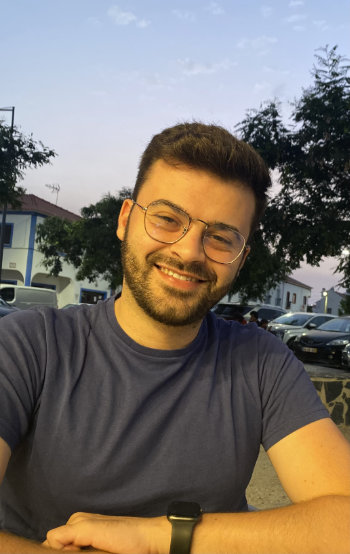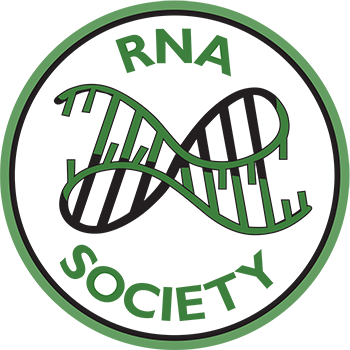Rui Sousa-LuísWritten by: Maxime Wery, PhD Posted: October 6, 2025  Rui Sousa-Luís is an RNA researcher and computational biologist. He is currently in the final stages before defending his PhD in Biomedical Sciences. Let's explore the path that led him to this important milestone. Rui earned his BSc in Biochemistry in 2016 from the Faculty of Sciences, University of Porto, Portugal. During this period, he was introduced to computational approaches, particularly theoretical chemistry, protein structure prediction, and molecular docking. He became fascinated by the prospect of contributing to science beyond traditional bench experiments and began teaching himself programming languages and bioinformatics during his free time. This interest led Rui to pursue a Master's in Bioinformatics and Computational Biology at the Faculty of Sciences, University of Lisbon. For his internship, he chose to join Professor Maria Carmo-Fonseca's lab at the Institute of Molecular Medicine (IMM) to study the regulatory impact of antisense transcription. Rui recalls the immediate connection with Professor Carmo-Fonseca. "We shared similar perspectives on science, priorities, and research philosophy. Joining her lab felt like the natural next step and proved to be the perfect fit for my goals and interests." This transition from traditional bench work to computational research marked a crucial step in Rui's training, showing him a breadth of research cultures and problem-solving approaches. "Mastering bioinformatics transformed how I think about experiments and gave me a toolkit that still shapes every project I tackle." After his Master's internship, pursuing a PhD with Professor Carmo-Fonseca was an easy choice. The opportunity became even more exciting when Rui was offered a joint doctoral project between Professor Carmo‑Fonseca's lab and Professor Nicholas Proudfoot's lab at Sir William Dunn School of Pathology, University of Oxford, United Kingdom. As he approaches the end of his PhD, he reflects that while this path initially seemed risky and unconventional, it has been his most rewarding career experience. "No one around me was doing anything similar. Yet that decision became the most enriching experience of my career: it let me bridge experimental and computational approaches, build two scientific networks, and co‑develop technologies like POINT that could hardly have emerged in a single setting." Managing a PhD project between two labs in different countries presents unique challenges. Coordinating across countries can be logistically complex, and switching between teams requires constantly rebuilding routines and communication channels. However, Rui credits clear planning, regular updates with both PIs and group members, and strong support systems in each location for helping him navigate these challenges. "Ultimately, the advantages, especially the trust and intellectual freedom I enjoy, far outweigh the hurdles." In fact, Rui considers the freedom and trust granted by both supervisors as one of the most valuable aspects of his work. "That autonomy is essential: it lets me pursue bold ideas, tailor experiments to the strengths of each lab, and grow into an independent scientist." Working between these labs has exposed him to complementary scientific cultures, mentoring styles, and technical approaches, broadening his perspective, expanding his network, and enhancing his adaptability.
Reflecting on his academic journey from biochemistry to computational biology, Rui notes a common thread: all his experiences emphasize curiosity-driven research and multidisciplinary approaches. His fascination with RNA biology stems from understanding RNA's central role in cellular processes, despite its historical overshadowing by DNA and proteins. The dynamic and often mysterious ways RNA regulates genes and shapes genomes drew him to this rapidly evolving field. Rui is particularly intrigued by transcription regulation and kinetics, especially how the transcription of one unit affects neighboring genes. "What fascinates me is that, although only up to 5% of the human genome encodes for mRNAs, nearly half of it is transcribed by RNA Polymerase II. Many of these transcripts never leave the nucleus and are not translated into proteins, yet they may still play important roles in modulating gene expression. There's still so much we don't understand about these non-coding transcriptional events, and uncovering their functions is incredibly exciting to me." Not surprisingly, Rui's favorite RNAs are the nameless, short lived, unspliced RNAs that RNA Polymerase II steadily produces. "These transcripts are only now being detected thanks to high throughput, high sensitivity methods. They rarely leave the nucleus and most have no assigned function (yet), but I find them fascinating because they embody the genome's spirit of experimentation. Even if most of them turn out to be non-functional today, they represent putative evolutionary trial runs. They are the raw material that natural selection can someday refine into new regulatory or coding roles. It's a reminder that genomes aren't static archives. They're constantly testing ideas, as a scientist in a lab." His proudest achievement has been co‑developing POINT technology (polymerase intact nascent transcript sequencing) with Dr. Takayuki Nojima through a collaboration between the Proudfoot and Carmo‑Fonseca labs. Published in a Molecular Cell paper in 2021, POINT captures and sequences intact nascent RNAs still engaged with RNA Polymerase II, opening new insights into transcription and RNA processing dynamics. Beyond creating a powerful tool for studying co‑transcriptional regulation, this work led to Rui's first oral presentation at the 2021 RNA Society meeting—an unforgettable moment in his career. Rui's favorite RNA journal article is 'Transcription and splicing dynamics during early Drosophila development' published in 2022 by Prudêncio et al. This study adapts native elongating transcript sequencing (NET‑seq) to intact fly embryos, precisely identifying RNA Polymerase II positions during canonical and recursive splicing. By linking nascent‑RNA profiling with developmental timing, the authors revealed how some introns splice immediately after transcription while others wait hundreds of nucleotides, connecting this timing to gene architecture and genome organization. "The work illustrates beautifully how cutting‑edge technology can answer classical questions about co‑transcriptional splicing and transcription termination in a living organism." It has inspired many of Rui's experiments on nascent RNAs and demonstrates how collaborations between colleagues can advance the field. Prior to this year, Rui has attended the last four RNA Society annual meetings, including the online edition during the pandemic. He values these meetings as yearly milestones for the community, describing each edition as a global reunion where new ideas, technologies, and projects emerge, and where future collaborators and friends are just a coffee break away. He recalls feeling the energy of RNA research in every session, with researchers worldwide openly sharing data, debating results, and spontaneously brainstorming. "Each meeting has broadened my horizons, introduced me to new methods, and connected me with new colleagues. Those experiences have enriched me enormously as a scientist and remind me why I look forward to the meeting each year." While Rui couldn't attend the RNA Society 2025 meeting in San Diego, he plans to return in 2026 as Dr. Rui Sousa-Luís. His advice to young scientists is to stay curious. "Don't be afraid to explore across disciplines: RNA biology thrives at the intersection of different fields. Computational skills, for example, can greatly enhance traditional bench work, and vice versa." Rui also emphasizes the importance of finding supportive mentors and collaborators who share your enthusiasm and values. "Science is deeply collaborative, and building strong, meaningful connections can transform both your research and your overall experience as a scientist." Follow Rui using his X account: @RSousaLuis |
